|
|
|
Sort Order |
|
|
|
Items / Page
|
|
|
|
|
|
|
| Srl | Item |
| 1 |
ID:
189067
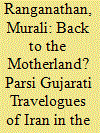

|
|
|
|
|
| Summary/Abstract |
The publication of four Gujarati travelogues written by Parsis traveling to Iran in quick succession in the 1920s marked the intensification of a relationship that had hitherto been based mainly on philanthropy directed towards the Zoroastrians of Iran. The Pahlavi regime, with its assurances of religious tolerance and equity, prompted Parsis to consider deepening their connection with Iran through trade and business investments and also examine the possibility of return to their motherland. The encounters which constitute these travelogues could be framed as experiments which helped the Parsi community in India to construct a framework for developing this relationship. The Parsi travelogues, while attempting to recover a Zoroastrian past in Iran, also try to map the future for the community by addressing its present anxieties and aspirations.
|
|
|
|
|
|
|
|
|
|
|
|
|
|
|
|
| 2 |
ID:
137182
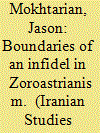

|
|
|
|
|
| Summary/Abstract |
This paper explores the Middle Persian term agdēn, which is often problematically translated as “infidel.” By tracing this term of otherness through Middle Persian texts such as legal cases in The Book of a Thousand Judgments and polemics in the Dēnkard Book III, this article argues that the concept of the infidel frequently appears in discussions about slavery, intermarriage, and conversion to and from Zoroastrianism. Middle Persian legal and theological texts regarding infidels deal with cases in which Zoroastrian interactions with non-Zoroastrians impinge upon Zoroastrian boundaries of identity. Moreover, the term agdēn often refers to Jews, Christians, and Muslims, thereby offering insight into the ties between Zoroastrian self-identity and other groups which the Persian priests encountered. In the end, this paper demonstrates the need for further intensive studies into Middle Persian technical terms of otherness as they lie at the heart of questions of Zoroastrian self-definition and attitudes towards others.
|
|
|
|
|
|
|
|
|
|
|
|
|
|
|
|
| 3 |
ID:
127340
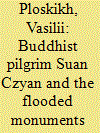

|
|
|
| 4 |
ID:
153013
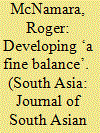

|
|
|
|
|
| Summary/Abstract |
This paper intervenes in the debate over whether secularism can protect religious minorities in India or whether alternative models are needed. I explore this issue by examining Rohinton Mistry's novel Family Matters, which focuses on religious extremism within the minority Parsi community. The novel suggests that the individual needs to maintain ‘a fine balance’ between religious beliefs and personal rights. It recognises that secularisation has shaped modern religious identity and, consequently, facilitated religious extremism. By de-coupling religion from secularisation, Mistry demonstrates that religion need not be rigid and can adapt to different social circumstances, while continuing to provide moral strength.
|
|
|
|
|
|
|
|
|
|
|
|
|
|
|
|
| 5 |
ID:
130802
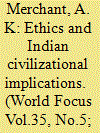

|
|
|
|
|
| Publication |
2014.
|
| Summary/Abstract |
The major civilizations of in human history have been associated with the major religious systems. Some
3,000 years ago Zoroastrianism was the religion of the "glory of ancient Persia," - the Persia that conquered" Babylon, Palestine, Egypt, and the Greek city-states. A few centuries later Judaism was the basis of Hebrew culture, which some philosophers such as Karl Jaspers regards as the greatest in history. And Jewish law has formed the I basis of common law and jurisprudence in countries all over the world. Western culture, until the rise of modem science, was dominated by Christianity. The teachings_ of Islam that burst upon world stage some 1400 years a go preserved and developed the Hellenistic heritage and gave algebra and other sciences. It was probably the greatest civilization the world had seen until the rise of the - Industrial Revolution began to transform Western culture. Today, the tumult of our age of transition is characteristic of the impetuosity and irrational instincts of youth. its follies, its prodigality, its pride, its self- assurance. its rebelliousness, and contempt of discipline.
|
|
|
|
|
|
|
|
|
|
|
|
|
|
|
|
| 6 |
ID:
184160
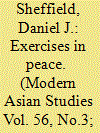

|
|
|
|
|
| Summary/Abstract |
In 1650, an encyclopedia of comparative religion known as Dabistān-i Maẕāhib (the School of Doctrines) was completed near the city of Hyderabad. Asserting that the religions of the world are reflections of a single inner truth, its author Mīrzā Ẕu'l-fiqār Āẕarsāsānī, known by the poetic penname ‘Mūbad’, travelled widely across India to record encounters with diverse religious figures. This article re-examines the composition and legacy of the Dabistān in light of new manuscript evidence relating to its author and the world he inhabited. It argues that the Dabistān's universalist project reflects a widely held theory of the interrelatedness of the macrocosm, in which sociality with diverse populations was understood to be a spiritual exercise leading to saintly perfection in the same way that venerating the cosmos and ascetic bodily practices were. The article provides a close reading of the Dabistān's shortest chapter on the religion of the Tibetans, the earliest such description in Persian. Situating the Dabistān within the diverse expressions of ‘Universal Peace’ (ṣulḥ-i kull) during the Safavid and Mughal periods, it argues that the Dabistān's project of recovering a universal theology that was attributed to ancient Iran and India led to expressions of dual religious belonging—to particular religions of revelation as well as to the universal religion of the philosophers—parallel to and connected with what Jan Assmann has termed the ‘religio duplex phenomenon’ in early modern Europe. Finally, the article briefly traces the legacy of the Dabistān into the modern period.
|
|
|
|
|
|
|
|
|
|
|
|
|
|
|
|
| 7 |
ID:
177048
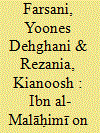

|
|
|
|
|
| Summary/Abstract |
The Kitāb al-muʿtamad fī uṣūl al-dīn by Maḥmūd b. Muḥammad Ibn al-Malāḥimī al-Khwārazmī (d. 536/1141) belongs to the Muʿtazilī theological works that present valuable insight into the intricate history of religions and their contacts. Recently, scholars have identified other manuscripts of this book which comprise passages absent in previously known manuscripts. The enlarged edition of 2012 now comprises the complete chapter on Zoroastrianism, of which only a short part was extant in the first edition. This article translates the whole chapter on Zoroastrianism, along with the vocalized Arabic original text, to make it more accessible to historians of Iranian religions. This translation is then followed by a discussion of the implications of this piece for the history of Zoroastrianism after Islam. After discussing the inner-textual structure of the text the inter-textual relations of this text are examined, along with al-Shahristānī’s account on Zoroastrianism. Through this comparison, it is shown that the major part of both texts most probably originates from the Radd ʿalā l-Majūs (Refutation of Zoroastrians) by Abū ʿĪsā al-Warrāq. In this way, the article shows that both al-Shahristānī’s and Ibn al-Malāḥimī’s texts are relevant for the history of Zoroastrianism in ninth-century Baghdad.
|
|
|
|
|
|
|
|
|
|
|
|
|
|
|
|
| 8 |
ID:
130827
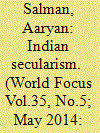

|
|
|
|
|
| Publication |
2014.
|
| Summary/Abstract |
"I believe in a religion based on universal and all-embracing principles which have always been accepted as true by mankind - the primeval eternal an religion, which means that it is above the hostility of all human an creels whatsoever. " - -Swami Dayananda Saraswati. There can be little debate on the In?uence of co Religion on Human History. The overwhelming impact of Christianity, Hinduism, Zoroastrianism, Judaism, or Islam on Civilization is seen not only in the cultural pl: semblance and value system which emerge from their - D2 teachings, but also re?ects in the effects they've had Ul on mankind. un an Believers and Unbelievers alike have acknowledged the profound in?uence of religion on ha individuals, societies and on humanity's collective life. the Religion was and is a power that's here to stay with above both the western and eastern hemispheres! that will On the other hand, Religion was and is still the considered a pariah' by Western Secularism! According are to historian R. Scott Appleby "Religion, at last, can no be longer be ignored". This was one of ?ve "unintended, unforeseen" consequences of 9/ l 1. HI In present day, challenges are manifold both co at domestic and at international level. Most political of con?icts end up passing through the prism of religion» pr. or ethnicity and are claimed to be the trigger factor in cl: many con?icts. The relationship between Religion and special Con?ict is complex.3'And Religion is at the heart of the Secularism Debate as Ethnicity and Religion have been an the building blocks of an lndividua1's Identity. Appleby hi: de?ned religion as 'the human response to a reality m: perceived as sacred
|
|
|
|
|
|
|
|
|
|
|
|
|
|
|
|
| 9 |
ID:
151330
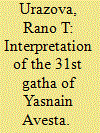

|
|
|
| 10 |
ID:
116307


|
|
|
|
|
| Publication |
2012.
|
| Summary/Abstract |
This collection addresses some of the major challenges facing scholars and practitioners who are dealing with the Caucasus, as well as with ethnic and ethno-religious relations in Eurasia and the wider world. The collection is one of the outcomes of a two-day international multi-disciplinary conference entitled 'The Caucasus and Central Asia: Theoretical, Cultural and Political Challenges', held at the University of Birmingham on 3-4 July 2009.
|
|
|
|
|
|
|
|
|
|
|
|
|
|
|
|
| 11 |
ID:
144717
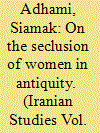

|
|
|
|
|
| Summary/Abstract |
Summary: The study of the feminine in ancient Iran is an area which deserves much greater attention than it has thus far received. By utilizing a number of primary sources, textual and otherwise, a few observations are offered here which concern the rites of women through the centuries. These evolving rites, which are described by the doctors of the then-dominant religion of Zarathustra, deal with the preservation of purity through seclusion of women in a world which is under constant attack from the demonic, polluting forces. Throughout the essay, the different means of fighting this battle are explored and suggestions for further research in the field are made.
|
|
|
|
|
|
|
|
|
|
|
|
|
|
|
|
| 12 |
ID:
152441
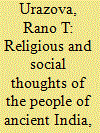

|
|
|
| 13 |
ID:
189068
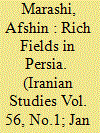

|
|
|
|
|
| Summary/Abstract |
This article investigates the history of economic relations between Iran and the Parsi community of India during the Reza Shah period. Encouraged by the policies of the new Pahlavi state, Parsi entrepreneurs began a serious effort to investigate the possibilities of economic investment in Iran. The article details three Parsi economic missions that were conducted in Iran during this period, and analyzes their assessments of Iran's potential for development in fields such as energy, textile manufacturing, commercial agriculture, and modern transportation systems. As the article argues, while these Parsi-led initiatives were part of a larger history of renewed engagement between Parsis and Iranians, for a variety of political and economic reasons, by the outbreak of World War II few of the Parsi plans for investment in Iran had come to fruition. While remaining largely forestalled in the interwar period, the article also suggests that Parsi economic assessments foreshadowed many of the planning strategies carried out in Iran's post–World War II history of economic development.
|
|
|
|
|
|
|
|
|
|
|
|
|
|
|
|
| 14 |
ID:
186915
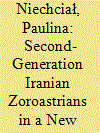

|
|
|
|
|
| Summary/Abstract |
The article contributes to filling the research gap concerning Iranian Zoroastrians in diaspora. Using a narrative approach, it explores how second-generation Zoroastrians raised in the United States learn and practice religion while facing the challenges of a pluralistic American society. The article includes a case study of two young Zoroastrian women interviewed in 2019, members of the Californian community. The contrastive cases shed light on the internal heterogeneity of Zoroastrianism, different ways the religion is perceived and experienced, and different ideas about future preservation of the ethno-religious heritage. The study contributes to an understanding of how Zoroastrianism evolves on a new continent and how it differs from what Zoroastrian immigrants brought from Iran.
|
|
|
|
|
|
|
|
|
|
|
|
|
|
|
|
| 15 |
ID:
120859
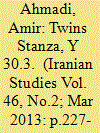

|
|
|
|
|
| Publication |
2013.
|
| Summary/Abstract |
The Gathic stanza Y 30.3 has always been at the center of various interpretations and controversies in Western scholarship on Zoroastrianism. Those who believe they have discovered in the Gathas a monotheistic religion armored with an ethical dualism have made this stanza one of the pillars of their thesis. The so-called Twins stanza shows, according to this view, that the good and evil primordial spirits exist as a result of their choice between Good and Evil, which preserves not only the absolute goodness of the supreme god but also his uniqueness. More recently Kellens and others following him have given a completely different reading of the stanza. According to their account, this stanza is a speculation on the hidden processes of ritual. What the poet expresses in Y 30.3 is not a dualism, ethical or otherwise, but a psychology of the process by which man makes his choice of ritual conduct. Aside from the question of coherence, one must ask whether these accounts are borne out by the text they claim as their basis. This article addresses these two questions.
|
|
|
|
|
|
|
|
|
|
|
|
|
|
|
|
| 16 |
ID:
124454
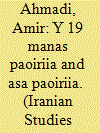

|
|
|
|
|
| Publication |
2013.
|
| Summary/Abstract |
Yasna 19 contains an Avestan exegesis of the G?thic stanza Ahuna Vairiia, the most revered text in Zoroastrianism. The stanza is traditionally understood to be the essential statement of the religion of Mazd?. Thus, in Y 19 we have a unique opportunity to ask about the significance that the G?th?s of Zarathuštra held for the later Avestan tradition. In what intellectual horizon did Zoroastrian priests place their founding text? Although Y 19 exegesis of the Ahuna Vairiia contains semantic obscurities, it is possible to establish the meaning of the commentary through syntactic and conceptual analysis of two key terms and the phrases where they occur. The article critically examines the earlier interpretations of the text. Having found these inadequate, it proposes a new reading and understanding of the Avestan exegesis. In particular, the article argues that the Avestan exegete understood the G?thic stanza within an eschatological horizon.
|
|
|
|
|
|
|
|
|
|
|
|
|
|
|
|
| 17 |
ID:
165770
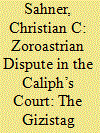

|
|
|
|
|
| Summary/Abstract |
The Gizistag Abāliš is a ninth- or tenth-century Pahlavi text, recording a debate which took place at the court of al-Maʾmūn between a Zoroastrian priest and a heretical dualist. This article, the first in-depth study of this important work, examines the text in its broader Islamicate environment. It argues that the narrative itself is probably fictional, but reflects a real historical phenomenon, namely the interreligious debates which took place among Zoroastrians, Muslims, Christians, and Jews during the ʿAbbasid period. It argues that the text is a unique Zoroastrian example of a literary genre that was common among Christians at the time, namely, “the monk in the emir’s majlis.” By comparing the Gizistag Abāliš to these Christian texts, it explores why Zoroastrians generally did not launch explicit polemics against Islam, comparable to those of other non-Muslim communities. It seems that Zoroastrian authors were more concerned with explaining their own doctrines than critiquing the beliefs of others. This is curious considering the large numbers of Zoroastrians who were converting to Islam at the time. Finally, the article proposes new ways of refining the way we read Pahlavi texts, by analyzing them alongside the literatures of other religious communities in the early Islamic empire.
|
|
|
|
|
|
|
|
|
|
|
|
|
|
|
|
| 18 |
ID:
130799
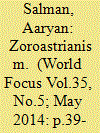

|
|
|
|
|
| Publication |
2014.
|
| Summary/Abstract |
"On three noble ideals be ever intent: The good thought well thought, the good word well spoken, the good deed well done." King Cyrus the Great is a towering ?gure in the history of humanity'. The reigning monarch of Superpower of the ancient world followed the footsteps of his ancestors and adopted ethical measures in his rule. Though he followed Zoroastrianism, he didn't force it on his subjects. In fact, it is acknowledged that he repatriated Jews back to Jerusalem from their exile in Babylon. He is ?rst Monarch to hold the title "The Great"? "He is known to be the first monarch in human history to grant rights to people of all nations in his empire.
|
|
|
|
|
|
|
|
|
|
|
|
|
|
|
|
|
|
|
|
|